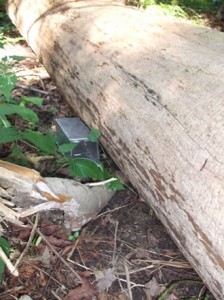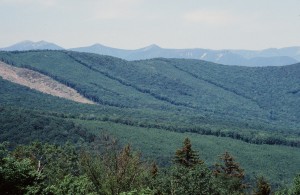To find out about an environment ecologists solve their problems like all scientists. They get an idea and guess, or hypothesize, what might be true. Gary could have guessed that a certain number of mice were in the forest. He might have supposed that small mammals were not a large part of the forest biomass.

Like any scientist, the ecologist must invent ways to gather data – facts, information – that might support or refute the original hypothesis. Gary trapped the mice to count them. He had to trap them in ways that gave unbiased numbers to put into his formulas. And he had to check his data for reliability. Gary snap-trapped to check his live-trap numbers.
Scientists analyze their data and figure out what the numbers mean. Gary counted mice. Perhaps there were more than he had guessed. But he discovered that his small mammals still made only a small part of the total forest biomass. After analyzing his data, he revised his hypothesis – changed his thinking – to fit what he discovered. By comparing data he generalized that mice add more biomass to an ecosystem than birds, but less than salamanders.
Scientific experiments and descriptive science may follow this general approach to a problem. But the steps do not always follow each other in the same sequence. One step may even be left out or skipped over to get to a general conclusion. A recipe may guide a cook who substitutes and adds ingredients in a different order. But if the cook is creative, the resulting dish is tasty. The scientist’s dish is new information about the world in which we live (basic science) or new knowledge about how to use the elements of our world (applied science).
Serendipity means a gift for making accidental fortunate discoveries. Scientists may be looking for one thing and discover something else that they were not looking for at all. Serendipity plays a big role in scientific progress and has helped add many new pieces of information to ecosystem puzzles.
Another concern of all scientists is scientific ethics. Scientists must be accurate and honest as far as possible in their reports of methods, measurements, and results. They cannot cheat by doctoring up measurements to turn out the way they would like them to be. Other scientists must be able to respect and depend upon a person’s work or they can’t use it. If a scientist is shown to be intentionally dishonest in their reporting in one instance, all the rest of their work may be suspected and unusable. All the work would have to be done over by someone with a good reputation.
What makes a person become an ecologist rather than another kind of scientist?
Ecologists are usually another kind of scientist first. They have a specialty, a deep knowledge of one scientific area. To this specialty they add a general knowledge of all parts of the environment and the interrelationships between the parts. And so the specialist forester, limnologist, botanist, zoologist, herpetologist, and ornithologist each become a scientific generalist, an ecologist.
Along with every new science comes a new vocabulary. Words convey ideas or concepts about things. If there are new ideas and new ways of seeing an old world, new words are needed to describe the new ideas. So ecologists have their own vocabulary. Some of the words may fool you. They can be common words used every day. But the ecologists have given them new meanings. A community can mean the town where you live. It can also mean all the plants and animals living in a common environment. To you a pioneer may mean a family in a covered wagon. To an ecologist it may mean an invading species – the first tree growing in a grassy meadow. The glossary at the end of this book will help you learn new meanings for old words and new ecological words too.
You and a mammalogist may know a lot about a cat and a mouse. But an ecologist may think of a cat as a predator and the mouse as prey when they are found in the same environment. Ecologists are quick to think of the relationships that exist between two or more things in an environment.

A botanist may see a pine forest. The ecologist sees a climax forest where the young trees are the same species as mature trees. She sees dead trees decaying and materials being returned to the forest system for recycling.
A geologist may see granite rock exposed by a road cut. An ecologist will see that the primary invaders of lichen and mosses attached to the granite are beginning the process of soil formation.
A vacationer will see morning sun on a green mountainside. The ecologist will see a southern exposure with drier and warmer growing conditions than a nearby northern exposure. She knows which plants can grow on the southern slope, and the plants tell her which animals may be found living in the community.
Once you put on ecologist’s glasses, you do not see the world the same way any more. Your vision is clearer and wider. You see much more of the world than you did before using special glasses.
Natural history – the study of the life cycles of individual organisms and their behavior – was a stepping-stone to the science of ecology. Ecology has been referred to as “quantified natural history.” As you saw in each of the studies undertaken at Hubbard Brook, counting and getting numbers of each kind of organism was an important part of the work. To quantify something is to count it or show how much of it is present.
But ecology is much more than counting, and the ecologist is more than a counter. He or she recognizes the relationships – how one thing acts on another – in the total environment or ecosystem. Until relationships are known in any ecosystem, successful control and management of the resources on Planet Earth are difficult. We see the results of mismanagement daily in the newspaper headlines: flood, drought, endangered species, overpopulation, famine, energy crisis, mercury poisoning, oil spills, global warming. Some of the causes of inflation and unemployment can be traced to ignorant manipulation of our natural resources.
All parts of the environment are woven in an intricate web. When something happens to one strand of the web, it takes a lot of knowledge to know what may happen to all the other strands. As ecologists piece more ecosystem patterns together and design experiments that test each individual strand, managers of land and water will be able to predict more accurately what will happen when a forest is cut, a dam is built, or a field is sprayed with an insecticide.
